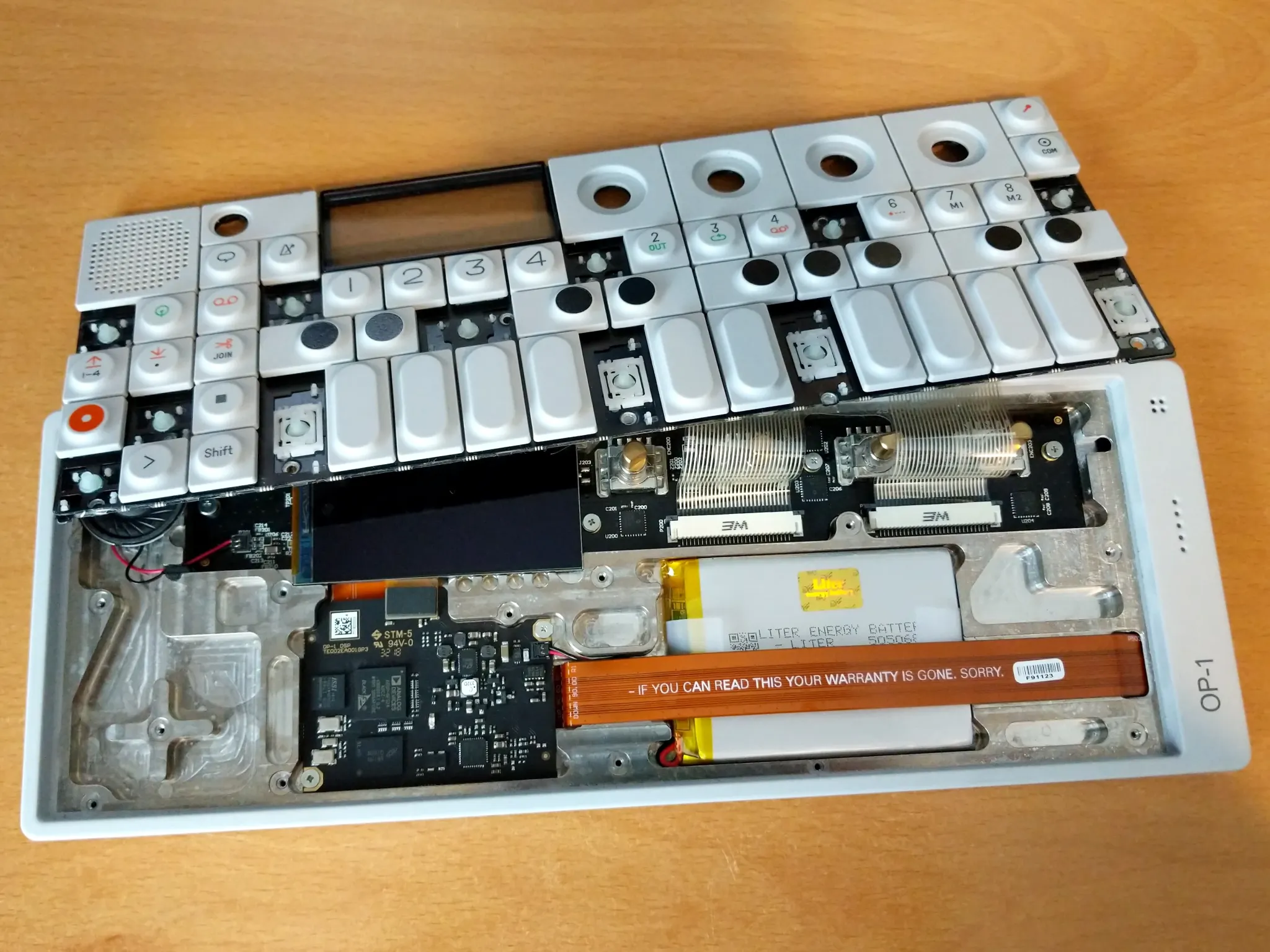Week 123: Operator One
I found a defective Teenage Engineering OP-1 on eBay on Monday, and, after haggling down the price a bit, bought it. It was described as working well, but not holding a charge. That turned out to be true, as it would only last a few minutes on battery even after charging.
There’s a comprehensive guide to replacing the battery, so I was confident about being able to do so as long as I could find one to fit. An official replacement battery is available, but it costs $100. Even if I were happy with the huge markup, it only seems to be available in the continental US, and that’s useless to me.
The official part is a 3.7 V 1800 mAh lipo battery with a size of
055070, i.e. 5 mm × 50 mm × 70 mm, and anything within
those dimensions will do. I found a 505068 (50 and 05 can both mean
5 mm thick) battery on eBay for £11. It claims 2500 mAh capacity,
but I suspect that’s on the boastful side. For the £70-odd I saved, I didn’t
get the oddball connector, so I had to graft that on from the old battery with
solder and heatshrink tubing. This is easy enough as long as you’re careful not
to short circuit it at any point, so don’t cut both wires at the same time, and
insulate the connection on one wire before cutting and joining the other.

The OP-1, battery replaced, ready for reassembly. I added tape handles around the battery to make it easier to remove in future, as this one is a very tight fit.
I charged it for a few hours, and … nothing happened. It wouldn’t turn on. So I disconnected and reconnected the battery (I had the foresight not to reassemble it fully until I had it working again) and it sprang into life. It’s been fine since, although it seems to be a bit choosy about which chargers it will actually charge from. The battery life is fantastic, though: I left it on for a whole day and it didn’t eventually run out of power until some time in the night.
I’m happy to finally have the chance to play with one, many years after I first tried and failed to buy one. I ordered one in October 2018, expecting to have to wait a couple of months. That slipped from November/December to January, until:
Unfortunately, Teenage Engineering have put the OP-1 on a ‘production break’, due to material shortage. While they haven’t officially discontinued the product, they are unable to confirm if/when we will see anymore.
My order was cancelled. The OP-1 came back into production in November 2019, at a full 150% of the previous price. I didn’t buy one, and now that Teenage Engineering has gone full Veblen with things like a £1855 pair of white cargo pants and a £1599 flat-packed desk, I had abandoned any thoughts of buying an OP-1 or its even more expensive successor, the £1799 OP-1 field.
But what is it like? Very flexible in some respects, and limited in others. It seems to make quite a good musical scratchpad for ideas. I think I’d be frustrated by the limitations even at its 2018 price. I’m going to hang on to it for a while, and see if it’s something that I can use in the park or on long train journeys. I’m not sure it will replace the Yamaha QY-70 from 1997 in my heart, however.
I gave my acoustic guitar a proper setup and filed the nut slots down to a sensible height. An excessively high nut has a huge impact on playability and intonation, and it’s now much easier to play, especially in the first few frets.
Almost every guitar on sale has a nut cut too high. It’s easier to manufacture them that way, and the move to online sales and squeezed margins has made a post-purchase setup even less likely, so they tend to stay that way.
There’s a bit of a knack to filing the nut, but it’s not hard if you have the proper tools. Nuts are cheap, so you don’t have to worry too much about making a mistake. Unfortunately, the proper tools are expensive: my set of Japanese nut files cost a bit more than the guitar.
That means that most people are struggling with hard-to-play instruments, and I think it’s a real shame.
We bought some tomato plants at the Surrey Docks Farm Spring Fair. I wonder who will win this year, us or the invertebrates. Actually, I think a squirrel ate half a tomato last year. It probably won’t be us.
As every year, I watched the Eurovision Song Contest broadcast live. I thought the eventual winner, Loreen from Sweden, was worthy, but my favourites were the oddball ones: Belgium, Finland, and Australia. The British performance was not good at all: the song was catchy, but the singing was poor. They tried hiding the out-of-tune vocals in the mix, but that just doesn’t work.